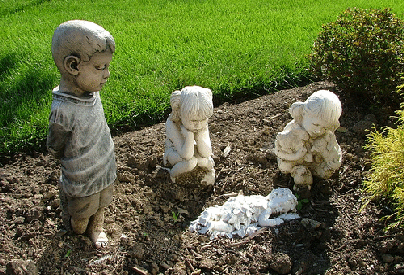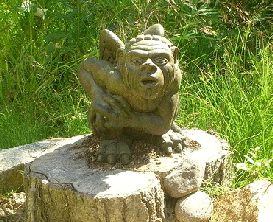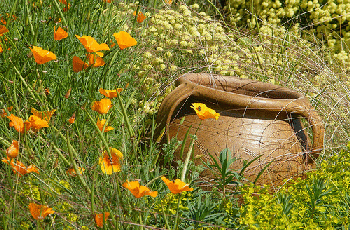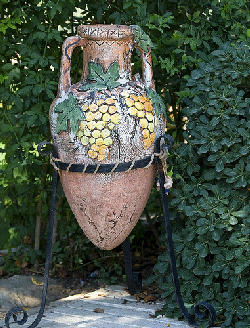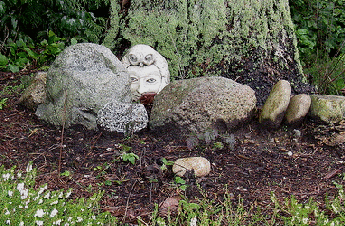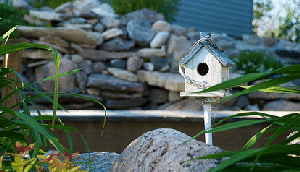Garden Accent Ideas
Basic Design Principles can Help You Select Garden Accents and Accessories
Selecting and placing garden accents and accessories that complement your landscape is not always an easy task. Finding a balance between selecting items that reflect your personality but that are harmonious with your landscape design sometimes involves a little compromise. How many times have you seen a fabulous piece for either your home or garden, but you just know it won’t look right. Or you buy it anyway and end up “redecorating” around the piece. Starting with an empty slate or simple design that is still maturing, that fabulous piece might just be a great starting point.
Keeping design principles in mind, perhaps you will find a little inspiration and guidance here. Examples of good design are very helpful, but first, just a couple of examples of “don’t do this!” is in order with accents. We tend to see accent pieces one item at a time as we acquire them, allowing the overall design to get out of control. Take a step back and evaluate each piece and placement.
Statues, sculptures, figurines
Keep a few things in mind to determine placement of statures, sculptures or figurines. Larger statuary will set the tone for your garden design, so make sure it works well with the existing style and that it sets the desired tone. In casual designs a statue should be set off to one side rather than centered. Just about any statue is best when tucked into foliage, accompanied by plants, or grounded by a pedestal or pavers. Try to achieve what would be a natural setting if the statue were real.
Both great examples of creating a natural appearance with statue placement, it is easy to imagine a dog snoozing by the coolness of foliage or two child angels whispering and giggling half hidden.
This clever composition required some thought and planning. Creating a scene with child statues takes grouping similar items a step further. Small children watching a sleeping baby they have come upon is a completely believable scene.
Gargoyles are quite naturally at home on a perch, whether a stump, wall, or pedestal.
Using a gargoyle, lion or chinese dog statue can work well to bookend a garden wall or hedge. This creature has his own pedestal perch, or the wall could be used as a perch.
Statues need to be “connected” to your landscape by creating a grounded place such as these pavers or stepping stones, or partially tucking them into foliage like this garden angel. On the left , a composition is created by using items made of similar material. The gray of the figure is repeated in the pale gray pavers, and the floral decoration on the pot. On the right, note in the left background a similar figure creates rhythm and unity by unevenly spacing themed figures through the design to lead your attention around the gardens.
Garden and landscape statues and sculptures don’t have to be formal or by any means ordinary. Some really make a statement and can show your personality. But unless you have a real statement to make or find an interesting conversation piece, be careful that your piece does not overpower or compete with the overall design.
This owl carving is perched quite naturally on a tree stump. The rustic style works very well with the setting and adds interest to an otherwise uninteresting corner.
This whimsical little pack of dogs could add a little interest to any number of spots without competing with other elements.
Little garden gnomes, fairies and angels are pretty easy to tuck into groupings of container plants or foliage just about anywhere in the landscape. But don’t tuck them into too many places unless you have a cottage garden style. Perhaps designate a specific area like the perennial garden for the little darlings.
This is a lovely composition created around a centerpiece container of lush foliage and red blooms. The two identically planted small blue containers draw the eye down to the lower level without competing with the centerpiece. The pumice stones and pumice fairy balance the composition and add brightness but in a natural material to unify the grouping with the wood deck.
This conversation piece could be hard to resist for some of us. But something like this must be a clear statement of your personality.
A buddha bust may not be a common garden ornament, but for a more formal oriental design this is perfect. The fence style is very interesting and should not be hidden, but the tall greenery calls attention to the fence spears. The upright stature of the bust and pedestal complements the vertical lines but also adds a little width and grounds the strong vertical composition to the surface.
Simple rock sculptures have become very popular. It conveys a very personal touch by trying the art of balancing, stacking, and composing rocks. The use of such a natural material makes rock sculpture appropriate in any garden design and setting.
This bed of simple foliage and textures benefits from a strong accent to add interest and call attention to the planting. Note that even bright blooms does not really call for much attention among the mulch and greenery. But smooth white stones and a white stone sculpture is just the contrast needed.
Planters, urns, and clay or ceramic pots are versatile garden accents. Style and color options are endless, and the plants you choose to highlight by elevating them can make a big impact.
A piece of basic pottery seemingly forgotten in a field of flowers calls attention to subtle planting. The most basic piece of pottery can be used to call attention to something special or allow you to just place accent plants on hard surfaces.
Urns, pottery and planters that are highly decorative are sometimes best left empty to show off the design of the piece. Choose pieces with distinct design carefully to complement current elements. Natural pottery materials with design or carvings that mimic nature are fairly easily unified with plantings. The geometric nature of mosaic designs also work fairly easily into many designs, but try to select color combinations that are repeated in other elements of your design.
Plant containers are easily included in island beds and perennial or shrub borders. Arrangements of three different accessories unified with greenery creates a pleasant grouping. The three pieces should have something in common, either material, color or theme. Tall urns can give a special or focus plant prominence in the arrangement.
Evenly spaced identical accessories creates a very formal design. The simplicity and repetition are key to formal gardens. It is difficult to create a casual design with the principles reserved for formal gardens, but a similar feeling could be created using less formal elements in a traditional landscape.
Gazing balls, birdbaths and small fountains can be used in similar ways, but each evokes a different mood. Gazing balls are intended to create interesting reflections, usually the colors of a perennial garden. Birdbaths are ideal to attract nature in a perennial or butterfly garden. Gurgling fountains create a calming feeling near a sitting area.
High color contrast commands attention. The gazing ball could repeat a color used elsewhere in the gardens or landscape. A gazing ball is one of those exceptions to the rule though. They seem every bit as happy and pleasant when they are breaking all design rules.
A great variety of posts, pillars, stands and spikes are available for elevating your gazing ball to whatever height you prefer. Some are highly decorative and call complement your gazing ball. When selecting separately, make sure the two elements complement or support each other. The blue porcelain style pillar above right would be much more pleasing with a blue or silvery ball, or the vivid pink of the roses. The pillar, ball and roses are each fighting for attention, not working together at all.
New twists on the gazing ball abound. No longer just of traditional glass, you will find stainless steel, copper, reflective mosaic and even non-reflective stone or pumice looks. This mosaic is beautifully coordinated with a simply designed short pedestal. The design is just bold enough to support the strong mosaic without fighting each other.
A bird bath tucks into a planting bed easily for a subtle accessory. Full of foliage of varying height, form and texture, rhythm is created with blooms of lavender pink. The birdbath is a supporting accessory here, not a focal point.
Nothing creates a calming mood better than a soothing fountain. This quiet corner is perfect for relaxing on a cushy bench, the fountain gurgling nearby. The fountain is the focal point of the sitting area, prominently centered and punctuated with a boxwood hedge. Heavenly!
Small wall and container circulating fountains that do not require plumbing or special electrical wiring are available as self contained units or kits that make it possible to easily include a fountain accent in your design. Any kind of water feature blends easily into most designs and styles. And these new units can be easily used on a deck, patio, flower bed, entry area, or to create a focal point.
Many styles and sizes available in fountain kits make it easy to create a water feature or small pond.
This simple fountain design on a pedestal makes the fountain easy to tuck into corners, perennial gardens, island beds or entry areas.
The easiest accents to use in garden design are natural elements such as rocks, boulders, driftwood, even stumps. Especially when working on a grouping or composition that needs just a little something, natural elements will help balance and unify the design without detracting from important pieces.
A design grouping at the entrance to your property is easily accomplished with large natural elements. The brick pillar of natural stone with a lantern lamp sets a formal tone for the entrance grouping. The large boulders (three to be precise - uneven number!) continue the theme of natural stone, repeating the mortar color from the pillar. A few clumps of willowy grasses softens the hard elements and creates unity with the foliage of the backdrop.
A shade garden is difficult to accent with colorful plants or blooms. Try using accessory accents instead to create interest instead. Bamboo reeds create a decorative mini fence to call attention to small bright hostas. Rocks are arranged naturally in a cluster to fill an empty spot, with a few scattered nearby.
A painted fence of muted barn red needs creates a colorful backdrop for simple foliage and natural bolder accents in this corner island bed. The simple composition provides relief for the large expanse of color. Note that the although an even number of boulders is used, there are three large natural accents with the tree.
A dead oak tree becomes a beautiful sculpture, creating an arch over the pathway. Vines creeping across the arch adds to the natural charm.
Another difficult place to add interest is the base of a tree, since planting is not possible. Stones and small boulders are subtle arranged in the mulch, but a bright peeking face from the rock is an eye catching surprise.
Plants are generally thought of as major elements of the design, but they also make excellent natural accents. A cluster of three blooming containers call attention to exit from the patio. The bright red impatiens draw the eye toward bright accent globes in a dark corner. And the bright foliage in the border garden lead the eye along to the next feature.
An unusual find or prized piece is an ideal focal point. Create a planting bed or grouping that supports the piece and shows off your personality.
Groupings of work items or memorabilia is another way to make a personal statement. Or just accent a very functional item with paint or plants. Recycle interesting items or items that you can make interesting. Display brightly painted birdhouses, especially if your kids made them! Or create a bright setting for a birdhouse.
Use small garden accessories in carefully chosen places. Garden accessories are available for any spot - on a stake, for a wall, or to hang. Or hang wind chimes to create soothing music while you relax on the deck or work in the garden.


